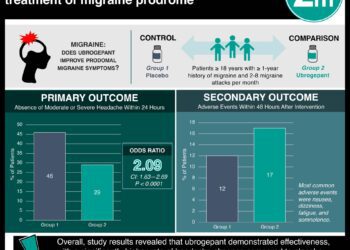Sham procedures effective in generating placebo effect among migraine patients
Image: PD
1. Among 72 placebo-controlled randomized controlled trials for migraine prophylaxis, only sham acupuncture and sham surgery were significant predictors of response in placebo groups (P = .005 and P = .001, respectively).
2. Significantly more patients in sham acupuncture groups reported response than in oral pharmacological placebo groups (odds ratio, 1.88 [95% CI, 1.30-2.72]).
Evidence Rating Level: 1 (Excellent)
Study Rundown: Placebo controls play a very important role in trials to determine the effectiveness of medical treatments; they help tease apart which effects of a medical intervention may be attributable to the specific intervention being studied, and which may be due to the act of intervening itself. However, studies have shown that different types of placebo controls may elicit differential responses. A more informed understanding of the systematic variations of the improvements seen in placebo control groups could inform our interpretation of placebo-controlled trials and further clarify our ability to infer relative treatment efficacy from such trials. In this review, the authors aimed to determine whether different types of placebo treatments used in randomized clinical trials on the prophylaxis of migraine were associated with different effect sizes. They concluded that the amount of reduction in migraine frequency does vary systematically between different types of placebo, with sham acupuncture and surgery associated with more significant reductions. The response to these interventions could be as great as the mean response to active drugs. Though these findings support the hypothesis that some placebo treatments can trigger clinically relevant responses, further studies that test different types of placebo as well as active treatments directly against each other are necessary to establish a truly causal relationship.
Click to read the study in JAMA Internal Medicine
Relevant Reading: Do medical devices have enhanced placebo effects?
In-Depth [meta-analysis]: This study aimed to determine whether different types of placebo treatments used in studies of migraine prophylaxis are associated with different responses. Study authors identified randomized controlled trials (from inception to February 2012) on migraine prophylaxis that compared an experimental treatment with a placebo control group. The observation period following randomization had to be 8 weeks or greater. The primary outcome measured was proportion of participants who responded (experienced a reduction in attack frequency of 50% of more) to treatment. If this data was unavailable, authors used as a proxy reduction of 50% or greater in migraine days, the number of headache days, or headaches score or a significant improvement as assessed by patients or their physicians. Pooled random-effects estimates were calculated according to the type of placebo for the proportions of treatment response and meta-regression analyses identified sources of heterogeneity.
One hundred and two trials were deemed eligible, but 23 were excluded due to insufficient data. Of the 79 remaining trials, the placebo treatment was an orally administered placebo for a pharmacological drug in 35 studies; sham acupuncture (13); a pharmacological sham injection (10); an oral placebo for an herbal remedy (8); sham cognitive-behavioral treatment (8); sham electromagnetic device (3); and sham surgery (2). Analysis demonstrated that sham acupuncture (proportion of responders, 0.38 [95% CI, 0.30-0.47]) and sham surgery (0.58 [0.37-0.77]) were associated with a more pronounced reduction of migraine frequency than oral pharmacological placebos (0.22 [0.17-0.28]). In multivariate analyses, sham acupuncture and sham surgery were the only significant predictors of response in placebo groups (P = .005 and P = .001, respectively).
By Elizabeth Kersten and Andrew Bishara
More from this author: Outreach increases colorectal cancer screening among underserved; Clinical impression not reliable in identifying drug-seeking behavior; Industry influences on expert panels contribute to over-diagnosis; Undervaccination becoming more common, associated with increased patient admission rates; Overuse of colonoscopy widespread in the US; Silent myocardial infarctions more common than previously assumed
© 2013 2minutemedicine.com. All rights reserved. No works may be reproduced without expressed written consent from 2minutemedicine.com. Disclaimer: We present factual information directly from peer reviewed medical journals. No post should be construed as medical advice and is not intended as such by the authors, editors, staff or by 2minutemedicine.com. PLEASE SEE A HEALTHCARE PROVIDER IN YOUR AREA IF YOU SEEK MEDICAL ADVICE OF ANY SORT.




